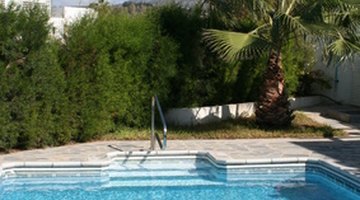What Is a Stabilizer for Pool Water?
Outdoor swimming pools are exposed to the elements of nature, and pool owners must use a variety of chemicals to keep the water safe to swim in. Unfortunately, chemicals that are unstable enough to kill harmful microorganisms are also unstable enough to break down when hit by sunlight.

One chemical that some pool owners add to their arsenal are stabilizers.
Stabilizer Function
Hypochlorous acid (chlorine) breaks apart very quickly when exposed to sunlight due to its instability. Cyanuric acid, commonly called a stabilizer, protects chlorine from UV rays. This increases the longevity of the chlorine and reduces how often pool owners need to add chlorine. Without stabilizers, the swimming pool will need up to twice as much chlorine. The stabilizers do not inhibit chlorine disinfectant activities or oxidation. The stabilizer and chlorine can combine to make chlorimide, which can still disinfect the water.
Pool Testing
Tests offered at pool centers let pool owners know when to add more stabilizers, with pools needing 20 to 40 parts per million (ppm). However, sunnier areas might need 40 to 80 ppm to handle the UV rays. Adding higher than 100 ppm can reduce the chlorine effectiveness and even lead to chlorine lock and cloudiness in the pool. Stabilizers do not leave the swimming pool except through backwash and splash out, so pool owners must test to know when to add more. When the pool has too much stabilizer, pool owners must remove some of the pool water and add new water to dilute the excessive stabilizers. Do not use chlorine with stabilizers already in it, because this can lead to excess.
Applying the Stabilizers
Stabilizers look like white powders or granules. Stabilizers dissolve slowly, so pool owners usually put them in warm water to speed up that process. Owners backwash the pool filter, remove the pump basket, restart the system with the filter on and slowly add stabilizers through the pool skimmer. The stabilizer reaches the pool filter where it sits until it dissolves enough to fit through the filter. If the pool has new water, add six pounds of stabilizers per 20,000 gallons of water. Pool owners wait a few days before backwashing the filter, and the low pH of the stabilizer might require chemicals to raise the pool pH.
Bromine
Pools with bromine don't need stabilizers because bromine does not break down in the sun. If a pool owner uses bromine and decides to switch to chlorine, the owner must completely drain and wipe down the pool before adding the chlorine and stabilizers.
The Drip Cap
- Outdoor swimming pools are exposed to the elements of nature, and pool owners must use a variety of chemicals to keep the water safe to swim in.
- Cyanuric acid, commonly called a stabilizer, protects chlorine from UV rays.
- Stabilizers look like white powders or granules.
- Pool owners wait a few days before backwashing the filter, and the low pH of the stabilizer might require chemicals to raise the pool pH.
- Pools with bromine don't need stabilizers because bromine does not break down in the sun.
- If a pool owner uses bromine and decides to switch to chlorine, the owner must completely drain and wipe down the pool before adding the chlorine and stabilizers.
References
Writer Bio
Charles Pearson has written as a freelancer since 2009. He has a B.S. in literature from Purdue University Calumet and is currently working on his M.A. He has written the ebooks "Karate You Can Teach Your Kids," "Macadamia Growing Handout" and "The Raw Food Diet."
Photo Credits
- Swimming Pool image by PinkSkyPhotos from Fotolia.com
- Swimming Pool image by PinkSkyPhotos from Fotolia.com
More Articles



